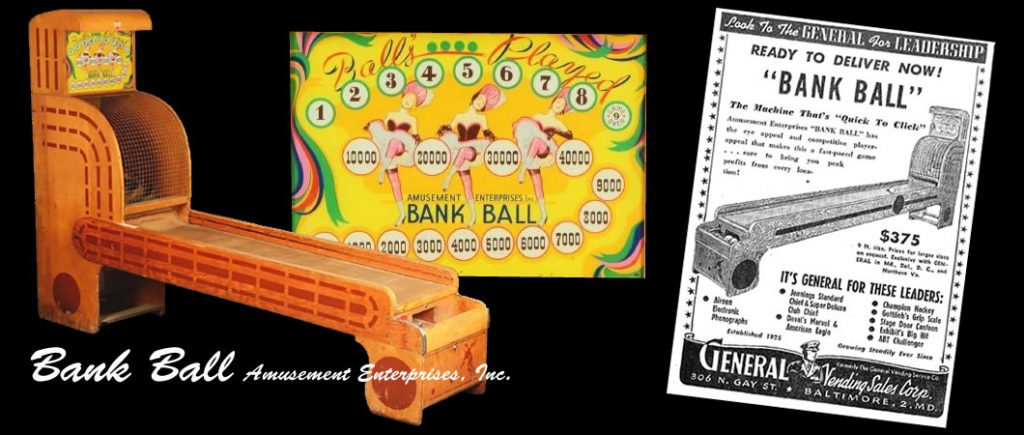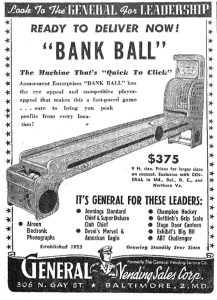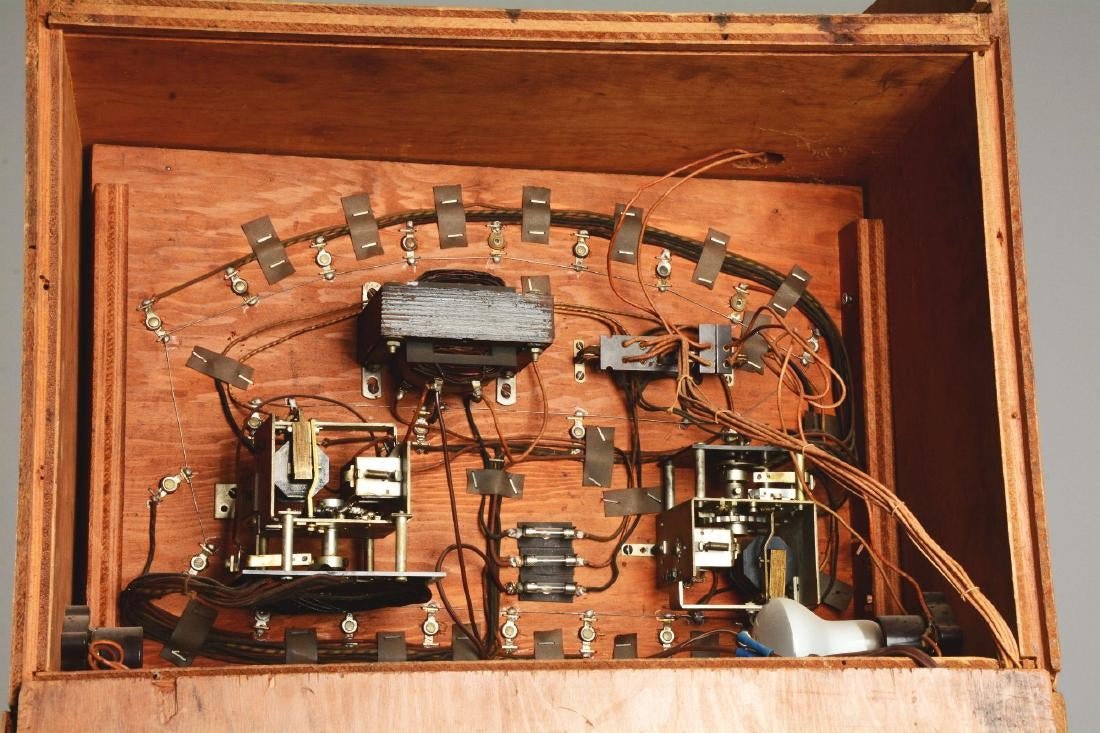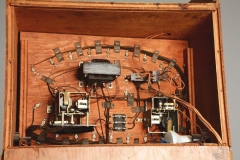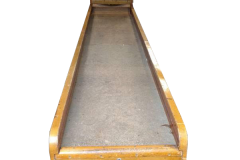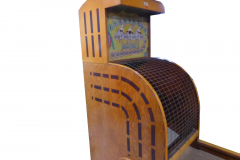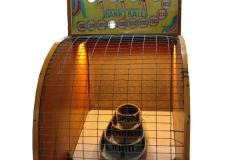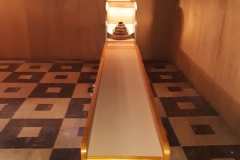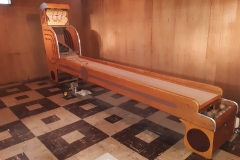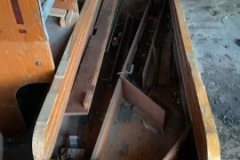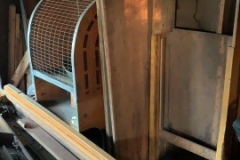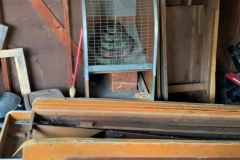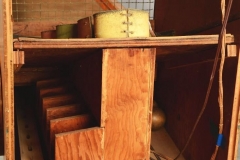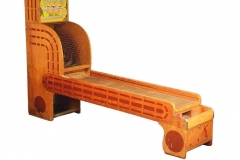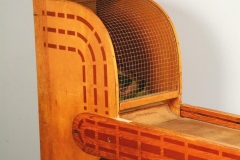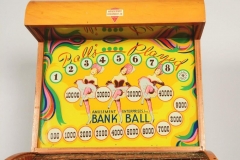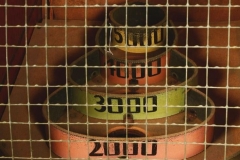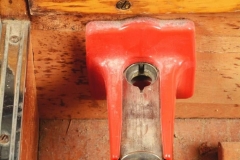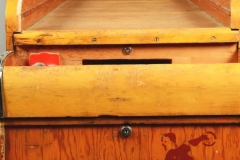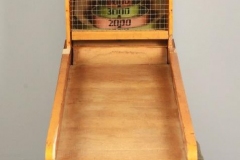Irving Kaye’s first enterprise mentioned in the coin-op section of Billboard magazine was Amusement Enterprises, Inc. based in New York City. Amusement Enterprises primarily manufactured coin-op bowlers. These “Skee-Ball” style bowlers had become quite popular and were being allowed in candy stores, bowling alleys, bars and amusement centers where non-skill games like trade stimulators and 40’s era pinballs (without flippers) were regularly being confiscated and destroyed by anti-gambling motivated authorities.
At the time of the article, in Aug 1945, Billboard reported over 1000 Bank Ball units were already on location with 700 additional in production. The story reported that Irving Kaye was able to obtain an injunction to restrain the license and police department from interfering with the operations of the machines. Bank Ball was declared legal and was not readily convertible to a gambling machine. By the mid 1940’s Skee-Ball type games had been around for almost 40 years.
When Skee-Ball was originally invented by Joseph Fourestier Simpson in 1907 the alleys were 32′ long! Then in the early 1930’s Julius Seidel, who was a tool and die maker for National Skee-Ball Company, Inc. built a 14’ skee ball alley in his shop on 42nd St. and Farragut Road in Brooklyn, NY. Julius sold his compact machine design to his employer for $500. Later National Skee-Ball sold the entire operation to the Rudolph Wurlitzer Company and then in 1946, Philadelphia Toboggan Company purchased the patents, trademarks, and rights to produce the Skee-Ball brand alleys (now owned by Bey-Tek Games Inc.)
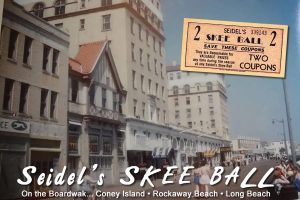
Son of Julius, Edward J. Seidel would later form Seidel Amusement Machine Co. manufacturing Bing-O-Reno and Pokereno roll down tables and other coin-op amusements. Seidel Amusement Machine Co. was also later acquired by Bey-Tek.
Julius’ Seidel’s smaller size tables sparked a revolution in the industry and they became quite popular as they were far more cost-effective to own and operate than the original 32′ designs. Julius went into business for himself manufacturing his smaller alleys and selling them directly from his workshop in Brooklyn, NY. and promoting them by taking out classified ads in the back of Billboard magazine. Julius’ was never a big player as an alley manufacturer but he, and later his son Edward Seidel, were the owners and operators of the world-famous “Seidel Skee-Ball” parlors with locations on the Long Beach, Rockaway and Coney Island, NY boardwalks. The increased popularity of these compact alley’s inspired other manufacturers like Irving Kaye to jump into the coin-op bowler business.
In the early to mid-40’s Amusement Enterprises, Inc. was formed and Irving Kaye and George Posner introduced their bowler called “Bank Ball” in 14′, 12′ and 9′ sizes. The Bank Ball coin-op bowler was Irving Kaye’s entree to the world of coin-op amusement manufacturing.
I have only seen three of these Bank Ball machines. One was sold at auction for an undisclosed amount but the auction estimate was $2000-$3000 in 2010. The second example is in the personal collection of IrvingKaye.com member “Scott the Junkman”. His ‘barn find’ Bank Ball that has been lovingly restored and is featured in his videos below. The third is an all-original unrestored Bank Ball in the personal collection of IrvingKaye.com member “Roger B”.
I was recently contacted by our member “Roger B” who sent me the last 3 pictures above of his all-original unrestored Bank Ball machine after he saw the pictures of Scott the Junkman’s amazing ‘barn find’ Bank Ball that he lovingly restored to like-new condition. The two images in the gallery above with the checkered floor are Scott’s amazing machine that is housed near motor-city USA. Check out Scott’s videos below:
